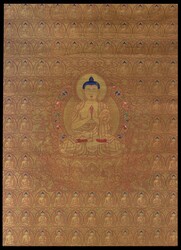
Buddhist Deity: Nageshvara Raja Buddha Main Page
Buddha Appearance Main PageSubjects & Topics:
- Description (below)
- Outline Page
- Nageshvara Raja & Retinue Figures
- Healing Deities
- Nagaraja Masterworks
- Buddha Number Sets
- Buddha Name Glossary
- Confusions: Arya Nagarjuna
- Others...
Video: Nageshvara Raja Buddha
Types of Iconography:
- Nageshvara Raja & Retinue Figures
- Nageshvara Raja (a host of bodhisattvas at the right, arhats on the left and nagas in front)
- Nageshvara Raja Accompanied by Four Bodhisattva
- Nageshvara Raja (The Sutra of the Three Heaps) form #1
- Nageshvara Raja (The Sutra of the Three Heaps) form #2
- Nageshvara Raja (The Sutra of the Three Heaps) form #3
- Others...
Buddha Nageshvara Raja, also known as Nagaraja (Tibetan: sang gye lu'i wang chug gyal po [bcom ldan 'das klu'i dbang phug rgyal po]. English: the Enlightened One, King of Nagas). This unusual buddha form has the unique blue body colouring and a face white in colour. He holds the two hands at the heart in a special gesture and the head is adorned with a hood of seven snakes. There are three primary purposes for practicing this meditational form of Nageshvara. The first is to employ Nageshvara as a meditational deity and remove defilements along with disease and obstacles created by naga spirits. Secondly, Nageshvara rituals are used to produce rain. Thirdly, Nageshvara is also employed in the creation of ritual vases with the intention of promoting environmental health and stability.
Nageshvara Raja has a similar appearance with several other popular iconographic forms commonly found in Himalayan and Tibetan art. It is very easy to confuse Nageshvara Buddha with Arya Nagarjuna and some forms of Shakyamuni Buddha. (See a comparison of these three figures).
Nageshvara Raja as a meditational deity in the Vajrayana system of Buddhism can be depicted in several different configurations. In paintings he is often depicted as a solitary figure or an accompanying figure in a large composition. Textually he is described as being with a host of bodhisattvas on the right side, a host of arhats on the left side and a host of nagas in front. He is also commonly described as having four accompanying bodhisattva figures: Nivarana-vishkambhin white in colour (front), Maitreya red (right), Manjushri yellow (behind) and Avalokiteshvara white (left).
Nageshvara Raja Buddha is also included as one of the Thirty-five Confession Buddhas. However, it is doubtful that there is any relationship between the Nageshvara Raja Buddha of the Confession Sutra and the meditational deity Nageshvara Raja popularized by Jowo Atisha. It is most probable that these two Buddhas became conflated over time primarily because of the similarity in name. It is also possible that this conflation is a convention established by Je Tsongkapa. The vast majority of Gelug Tradition paintings that depict the Thirty-five Confession Buddhas depict Nageshvara Raja Buddha in the same appearance as the meditational deity. Whereas most if not all Sakya, Kagyu and Nyingma Tradition paintings do not depict Nageshvara in the unique appearance of the meditational deity from the lineage of Jowo Atisha.
Lineage: Buddha Nageshvara Raja, Arya Nagarjuna, Chandrakirti, Dipamkara Atisha (982-1054), Rinchen Zangpo, etc.
Database Search: All Images
Jeff Watt 7-2011 [updated 5-2017]











